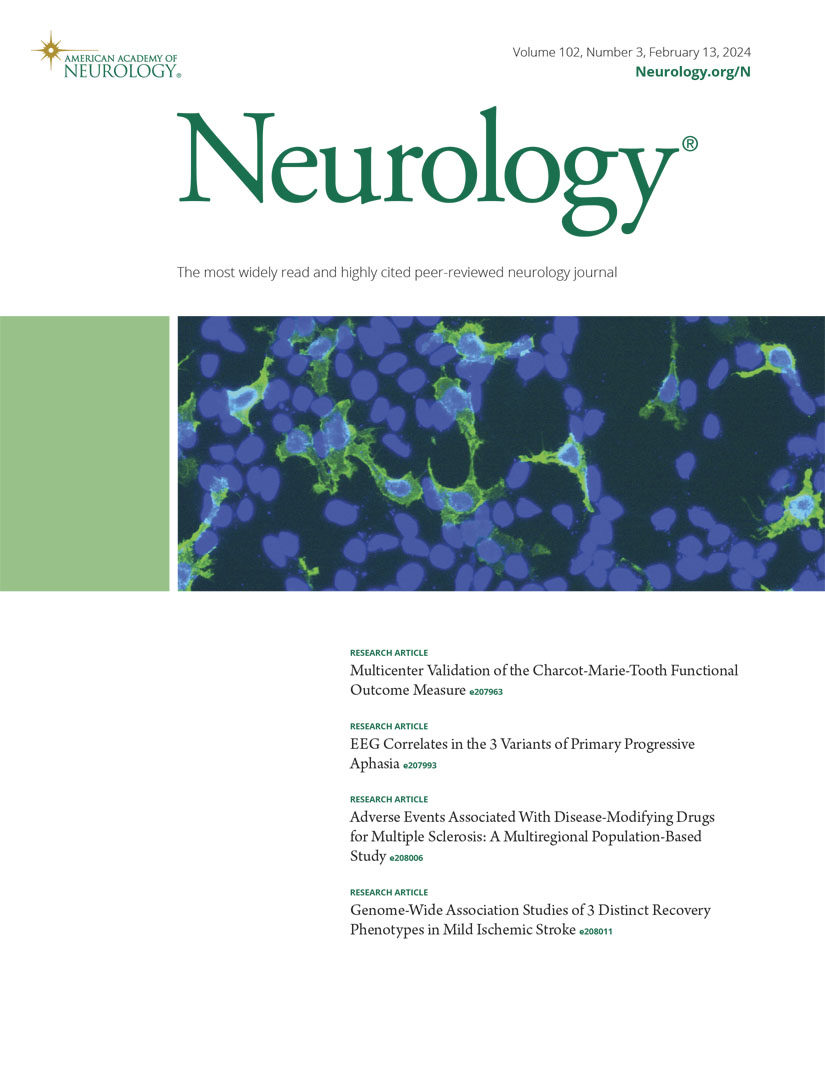Meta-Analysis of Randomized Controlled Trials on IV Thrombolysis in Patients With Minor Acute Ischemic Stroke.
IF 7.7
1区 医学
Q1 CLINICAL NEUROLOGY
引用次数: 0
Abstract
BACKGROUND AND OBJECTIVES The therapeutic efficacy and safety of IV thrombolysis (IVT) for patients with minor strokes remain a subject of significant debate and uncertainty. This meta-analysis aimed to assess the comparative effectiveness and safety of IVT vs nonthrombolytic standard of care (NT-SC) in minor strokes, focusing exclusively on data from randomized controlled trials (RCTs). METHODS A comprehensive literature search was conducted to identify RCTs evaluating IVT in minor stroke, defined as a NIH Stroke Scale (NIHSS) score ≤5. The primary outcome was excellent functional recovery, defined as a modified Rankin Scale (mRS) score of 0-1 at 90 days. Secondary outcomes included functional independence (mRS 0-2 at 90 days) and safety end points, including 90-day mortality, recurrent stroke, symptomatic intracranial hemorrhage (sICH), and any ICH. The study was registered with PROSPERO (CRD42024621714). RESULTS The primary analysis included data from 4 RCTs that exclusively enrolled patients with minor stroke (N = 3,364; age range: 56-80 years). Secondary analyses incorporated post hoc and subgroup data on patients with minor stroke from earlier RCTs. In the primary analysis, IVT was not significantly associated with higher odds of excellent functional recovery at 90 days compared with NT-SC (mRS 0-1; odds ratio [OR] 0.85, 95% CI 0.70-1.03). IVT was significantly associated with lower odds of achieving 90-day functional independence (mRS 0-2; OR 0.71, 95% CI 0.55-0.91) and higher odds of both sICH (OR 5.22, 95% CI 1.76-15.48) and 90-day mortality (OR 2.40, 95% CI 1.23-4.67) compared with NT-SC. Subgroup analysis showed a nonsignificant association of IVT with odds of excellent functional recovery across both groups with disabling symptoms (OR 0.84, 95% CI 0.38-1.88) and nondisabling symptoms (OR 0.82, 95% CI 0.66-1.03). The pooled analysis, which incorporated nonoverlapping subgroups and post hoc data, yielded consistent findings. DISCUSSION The findings suggest that IVT does not confer improved functional outcomes among patients with minor strokes and can be associated with higher odds of sICH and mortality at 90 days compared with NT-SC. Since most of the included patients presented with nondisabling minor strokes, additional studies on patients with mildly disabling symptoms are warranted.轻度急性缺血性卒中患者静脉溶栓的随机对照试验荟萃分析。
背景与目的静脉溶栓(IVT)治疗轻度中风患者的疗效和安全性仍然是一个有争议和不确定性的话题。本荟萃分析旨在评估IVT与非溶栓治疗标准(NT-SC)在轻微卒中中的比较有效性和安全性,仅关注随机对照试验(rct)的数据。方法采用文献检索方法,选取评价IVT治疗轻度卒中的随机对照试验(rct),以NIH卒中量表(NIHSS)评分≤5分为标准。主要结局是良好的功能恢复,定义为90天的修正Rankin量表(mRS)评分0-1。次要终点包括功能独立性(90天mRS 0-2)和安全性终点,包括90天死亡率、卒中复发、症状性颅内出血(sICH)和任何脑出血。该研究已在PROSPERO注册(CRD42024621714)。主要分析纳入了4项随机对照试验的数据,这些随机对照试验只纳入了轻度卒中患者(N = 3364;年龄范围:56-80岁)。次要分析纳入了早期随机对照试验中轻度中风患者的事后和亚组数据。在初步分析中,与NT-SC相比,IVT与90天良好功能恢复的几率没有显著相关性(mRS 0-1;优势比[OR] 0.85, 95% CI 0.70-1.03)。IVT与实现90天功能独立的几率较低显著相关(mRS 0-2;OR 0.71, 95% CI 0.55-0.91),与NT-SC相比,sICH (OR 5.22, 95% CI 1.76-15.48)和90天死亡率(OR 2.40, 95% CI 1.23-4.67)的几率更高。亚组分析显示,IVT与两组失能症状组(OR 0.84, 95% CI 0.38-1.88)和非失能症状组(OR 0.82, 95% CI 0.66-1.03)良好功能恢复的几率无显著相关性。合并分析纳入了非重叠亚组和事后数据,得出了一致的结果。研究结果表明,与NT-SC相比,IVT不能改善轻度卒中患者的功能结局,并且与90天sICH和死亡率的更高几率相关。由于大多数纳入的患者表现为非致残性轻微中风,因此有必要对轻度致残症状的患者进行额外的研究。
本文章由计算机程序翻译,如有差异,请以英文原文为准。
求助全文
约1分钟内获得全文
求助全文
来源期刊

Neurology
医学-临床神经学
CiteScore
12.20
自引率
4.00%
发文量
1973
审稿时长
2-3 weeks
期刊介绍:
Neurology, the official journal of the American Academy of Neurology, aspires to be the premier peer-reviewed journal for clinical neurology research. Its mission is to publish exceptional peer-reviewed original research articles, editorials, and reviews to improve patient care, education, clinical research, and professionalism in neurology.
As the leading clinical neurology journal worldwide, Neurology targets physicians specializing in nervous system diseases and conditions. It aims to advance the field by presenting new basic and clinical research that influences neurological practice. The journal is a leading source of cutting-edge, peer-reviewed information for the neurology community worldwide. Editorial content includes Research, Clinical/Scientific Notes, Views, Historical Neurology, NeuroImages, Humanities, Letters, and position papers from the American Academy of Neurology. The online version is considered the definitive version, encompassing all available content.
Neurology is indexed in prestigious databases such as MEDLINE/PubMed, Embase, Scopus, Biological Abstracts®, PsycINFO®, Current Contents®, Web of Science®, CrossRef, and Google Scholar.
 求助内容:
求助内容: 应助结果提醒方式:
应助结果提醒方式:


